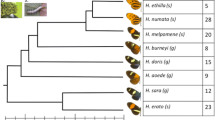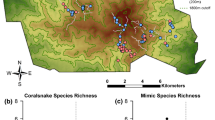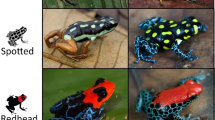Abstract
Conspicuous colouration in unpalatable organisms acts as a warning signal of their unprofitability, a phenomenon known as aposematism. The protection conferred by such colouration can lead to evolutionary convergence in warning signals between aposematic species, because sharing warning signals reduces the per capita cost of predator learning. Consequently, most aposematic species display a single colour pattern and participate in a single mimetic community (i.e. mimicry ring) at any given locality. However, some, like the Amazonian butterfly Heliconius numata, are polymorphic and participate in several mimicry rings within the same locality. We tested whether the unexpected polymorphism of H. numata could be due to a weak defence against predators. Poorly defended species participating in a mimicry ring are subject to negative frequency dependent selection, because their presence weakens the protection provided by the shared signal. This could promote polymorphism and participation in multiple mimicry rings. Using wild caught great tits (Parus major), we compared the palatability of H. numata to one of its locally monomorphic co-mimics (Mechanitis polymnia) and to two other locally monomorphic Heliconius species (H. melpomene and H. erato). The tested birds strongly rejected the polymorphic species H. numata, as well as the two other Heliconius species. Unexpectedly, a significantly weaker rejection was found towards M. polymnia, which relies on different toxic compounds to Heliconius. Our study demonstrates that the origin of polymorphic mimicry in H. numata is unlikely to stem from low unpalatability and raises new questions on defence variation within mimetic communities.


Similar content being viewed by others
References
Alatalo RV, Mappes J (1996) Tracking the evolution of warning signals. Nature 382:708–710. doi:10.1038/382708a0
Aubier TG, Sherratt TN (2015) Diversity in Müllerian mimicry: the optimal predator sampling strategy explains both local and regional polymorphism in prey. Evolution. doi:10.1111/evo.12790
Balogh AC, Gamberale-Stille G, Leimar O (2008) Learning and the mimicry spectrum: from quasi-Bates to super-Müller. Anim Behav 76:1591–1599
Barnett CA, Bateson M, Rowe C (2014) Better the devil you know: avian predators find variation in prey toxicity aversive. Biol Lett 10:20140533
Bates HW (1862) XXXII. Contributions to an Insect Fauna of the Amazon Valley. Lepidoptera: Heliconidæ. Trans Linn Soc Lond 23:495–566. doi:10.1111/j.1096-3642.1860.tb00146.x
Bates D, Maechler M, Bolker B, Walker S (2013) lme4: linear mixed-effects models using Eigen and S4. R package version, 1(4)
Baxter SW, Nadeau NJ, Maroja LS et al (2010) Genomic hotspots for adaptation: the population genetics of Müllerian mimicry in the Heliconius melpomene clade. PLoS Genet 6:e1000794
Brakefield PM (1985) Polymorphic Müllerian mimicry and interactions with thermal melanism in ladybirds and a soldier beetle: a hypothesis. Biol J Linn Soc 26:243–267. doi:10.1111/j.1095-8312.1985.tb01635.x
Brower LP, Brower JVZ, Collins CT (1963) Experimental studies of mimicry: relative palatability and Müllerian mimicry among neotropical butterflies of the subfamily Heliconiinae. New York Zoological Society
Brown K (1979) The biology of Heliconius and related genera. Ann Rev Entomol 26:427–456
Brown KS Jr, Benson WW (1974) Adaptive polymorphism associated with multiple müllerian mimicry in Heliconius numata (lepid. Nymph.). Biotropica 6:205–228. doi:10.2307/2989666
Camara M (1997) Predator responses to sequestered plant toxins in buckeye caterpillars: are tritrophic interactions locally variable? J Chem Ecol 23:2093–2106. doi:10.1023/B:JOEC.0000006431.34359.c2
Cardoso MZ, Gilbert LE (2007) A male gift to its partner? Cyanogenic glycosides in the spermatophore of longwing butterflies (Heliconius). Naturwissenschaften 94:39–42
Chai P (1986) Field observations and feeding experiments on the responses of rufous-tailed jacamars (Galbula ruficauda) to free-flying butterflies in a tropical rainforest. Biol J Linn Soc 29:161–189
Chai P, Srygley RB (1990) Predation and the flight, morphology, and temperature of neotropical rain-forest butterflies. Am Nat 135:748–765
Charlesworth D, Charlesworth B (1975) Theoretical genetics of Batesian mimicry II. Evolution of supergenes. J Theor Biol 55:305–324
Charlesworth D, Charlesworth B (2011) Mimicry: the hunting of the supergene. Curr Biol 21:R846–R848. doi:10.1016/j.cub.2011.09.004
Clark R, Brown SM, Collins SC et al (2008) Colour pattern specification in the Mocker swallowtail Papilio dardanus: the transcription factor invected is a candidate for the mimicry locus H. Proc R Soc B Biol Sci 275:1181–1188
Counterman BA, Araujo-Perez F, Hines HM et al (2010) Genomic hotspots for adaptation: the population genetics of Müllerian mimicry in Heliconius erato. PLoS Genet 6:e1000796
Daly JW (1995) The chemistry of poisons in amphibian skin. Proc Natl Acad Sci 92:9–13
Darst CR, Cummings ME (2006) Predator learning favours mimicry of a less-toxic model in poison frogs. Nature 440:208–211
Despland E, Simpson SJ (2005) Food choices of solitarious and gregarious locusts reflect cryptic and aposematic antipredator strategies. Anim Behav 69:471–479
DeVries PJ, Stiles FG (1990) Attraction of pyrrolizidine alkaloid seeking Lepidoptera to Epidendrum paniculatum orchids. Biotropica 22:290–297
Engler-Chaouat HS, Gilbert LE (2007) De novo synthesis vs. sequestration: negatively correlated metabolic traits and the evolution of host plant specialization in cyanogenic butterflies. J Chem Ecol 33:25–42
Exnerová A, Landová E, Štys P et al (2003) Reactions of passerine birds to aposematic and non-aposematic firebugs (Pyrrhocoris apterus; Heteroptera). Biol J Linn Soc 78:517–525. doi:10.1046/j.0024-4066.2002.00161.x
Fisher R (1958) The genetical theory of natural selection, 2nd edn. Dover Publications, New York
Gittleman JL, Harvey PH (1980) Why are distasteful prey not cryptic? Nature 286:149–150. doi:10.1038/286149a0
Guilford T, Nicol C, Rothschild M, Moore BP (1987) The biological roles of pyrazines: evidence for a warning odour function. Biol J Linn Soc 31:113–128. doi:10.1111/j.1095-8312.1987.tb01984.x
Hauglund K, Hagen SB, Lampe HM (2006) Responses of domestic chicks (Gallus gallus domesticus) to multimodal aposematic signals. Behav Ecol 17:392–398
Hay-Roe MM, Nation J (2007) Spectrum of cyanide toxicity and allocation in Heliconius erato and Passiflora host plants. J Chem Ecol 33:319–329
Hegna RH, Galarza JA, Mappes J (2015) Global phylogeography and geographical variation in warning coloration of the wood tiger moth (Parasemia plantaginis). J Biogeogr. doi:10.1111/jbi.12513
Huber B, Whibley A, Poul Y et al (2015) Conservatism and novelty in the genetic architecture of adaptation in Heliconius butterflies. Heredity 114:515–524
Ihalainen E, Lindström L, Mappes J (2007) Investigating Müllerian mimicry: predator learning and variation in prey defences. J Evol Biol 20:780–791
Ihalainen E, Lindström L, Mappes J, Puolakkainen S (2008) Butterfly effects in mimicry? Combining signal and taste can twist the relationship of Müllerian co-mimics. Behav Ecol Sociobiol 62:1267–1276
Ihalainen E, Rowland HM, Speed MP et al (2012) Prey community structure affects how predators select for Mullerian mimicry. Proc R Soc B Biol Sci 279:2099–2105. doi:10.1098/rspb.2011.2360
Joron M, Iwasa Y (2005) The evolution of a Müllerian mimic in a spatially distributed community. J Theor Biol 237:87–103. doi:10.1016/j.jtbi.2005.04.005
Joron M, Wynne I, Lamas G, Mallet J (1999) Variable selection and the coexistence of multiple mimetic forms of the butterfly Heliconius numata. Evol Ecol 13:721–754. doi:10.1023/a:1010875213123
Joron M, Papa R, Beltran M et al (2006) A conserved supergene locus controls colour pattern diversity in Heliconius butterflies. PLoS Biol 4:1831–1840. doi:10.1371/journal.pbio.0040303
Kokko H, Mappes J, Lindström L (2003) Alternative prey can change model–mimic dynamics between parasitism and mutualism. Ecol Lett 6:1068–1076. doi:10.1046/j.1461-0248.2003.00532.x
Kunte K (2009) The diversity and evolution of Batesian mimicry in Papilio Swallowtail butterflies. Evolution 63:2707–2716. doi:10.2307/27743426
Kunte K, Zhang W, Tenger-Trolander A et al (2014) Doublesex is a mimicry supergene. Nature 507:229–232
Lindström L, Alatalo RV, Mappes J (1997) Imperfect Batesian mimicry—the effects of the frequency and the distastefulness of the model. Proc R Soc Lond B Biol Sci 264:149–153. doi:10.1098/rspb.1997.0022
Lindström L, Alatalo RV, Mappes J et al (1999a) Can aposematic signals evolve by gradual change? Nature 397:249–251. doi:10.1038/16692
Lindström L, Alatalo R, Mappes J (1999b) Inherited avoidance towards colour, gregariousness and conspicuousness—experiments with naive and experienced predators. Behav Ecol 10:317–322
Lindström L, Alatalo RV, Mappes J (1999c) Reactions of hand-reared and wild-caught predators toward warningly colored, gregarious, and conspicuous prey. Behav Ecol 10:317–322. doi:10.1093/beheco/10.3.317
Lindström L, Alatalo RV, Lyytinen A, Mappes J (2001) Strong antiapostatic selection against novel rare aposematic prey. Proc Natl Acad Sci USA 98:9181–9184. doi:10.1073/pnas.161071598
Lindström L, Alatalo RV, Lyytinen A, Mappes J (2004) The effect of alternative prey on the dynamics of imperfect Batesian and Müllerian mimicries. Evolution 58:1294–1302
Lyytinen A, Alatalo RV, Lindström L, Mappes J (1999) Are European white butterflies aposematic? Evol Ecol 13:709–719
Mallet J, Gilbert LE (1995) Why are there so many mimicry rings? Correlations between habitat, behaviour and mimicry in Heliconius butterflies. Biol J Linn Soc 55:159–180
Mallet J, Singer MC (1987) Individual selection, kin selection, and the shifting balance in the evolution of warning colours: the evidence from butterflies. Biol J Linn Soc 32:337–350
Marek PE, Bond JE (2009) A Müllerian mimicry ring in Appalachian millipedes. Proc Natl Acad Sci 106:9755–9760. doi:10.1073/pnas.0810408106
Marples NM, Kelly DJ (1999) Neophobia and dietary conservatism: two distinct processes? Evol Ecol 13:641–653. doi:10.1023/A:1011077731153
Merrill RM, Dasmahapatra KK, Davey J et al (2015) The diversification of Heliconius butterflies: what have we learned in 150 years? J Evol Biol 28:1417–1438
Müller F (1878) Über die vortheile der mimicry bei schmetterlingen. Zool Anz 1:54–55
Nokelainen O, Valkonen J, Lindstedt C, Mappes J (2014) Changes in predator community structure shifts the efficacy of two warning signals in Arctiid moths. J Anim Ecol 83:598–605
Pinheiro CEG (1996) Palatability and escaping ability in neotropical butterflies: tests with wild kingbirds (Tyrannus melancholicus, Tyrannidae). Biol J Linn Soc 59:351–365. doi:10.1111/j.1095-8312.1996.tb01471.x
Pinheiro CEG (2003) Does Mullerian mimicry work in nature? Experiments with butterflies and birds (Tyrannidae). Biotropica 35:356–364. doi:10.1111/j.1744-7429.2003.tb00589.x
Pinheiro CE (2013) Jacamars (Aves, Galbulidae) as selective agents of mimicry in neotropical butterflies. Rev Bras Ornitol Braz J Ornithol 12:3
Pliske TE (1975) Attraction of lepidoptera to plants containing pyrrolizidine alkaloids. Environ Entomol 4:455–473. doi:10.1093/ee/4.3.455
Poulton EB (1890) The colours of animals: their meaning and use, especially considered in the case of insects. Kegan Paul, Trench Trubner & Co, London
R Development Core Team (2014) R: a language and environment for statistical computing. R Foundation for Statistical Computing. Vienna. http://www.R-project.org
Ritland DB (1991) Revising a classic Butterfly mimicry scenario: demonstration of Müllerian Mimicry between Florida Viceroys (Limenitis archippus floridensis) and Queens (Danaus gilippus berenice). Evolution 45:918–934. doi:10.2307/2409699
Rowland HM, Ihalainen E, Lindstrom L et al (2007) Co-mimics have a mutualistic relationship despite unequal defences. Nature 448:64–67. doi:10.1038/nature05899
Rubinoff I, Kropach C (1970) Differential reactions of Atlantic and Pacific predators to sea snakes. Nature 228:1288–1290. doi:10.1038/2281288a0
Saporito R, Donnelly M, Spande T, Garraffo HM (2012) A review of chemical ecology in poison frogs. Chemoecology 22:159–168. doi:10.1007/s00049-011-0088-0
Sheppard P (1975) Natural selection and heredity. Hutchinson, London
Sherratt TN (2008) The evolution of Müllerian mimicry. Naturwissenschaften 95:681–695
Sherratt TN (2011) The optimal sampling strategy for unfamiliar prey. Evolution 65:2014–2025. doi:10.1111/j.1558-5646.2011.01274.x
Sillén-Tullberg B (1985) Higher survival of an aposematic than of a cryptic form of a distasteful bug. Oecologia 67:411–415
Sillén-Tullberg B, Wiklund C, Järvi T (1982) Aposematic coloration in adults and larvae of Lygaeus equestris and its bearing on Müllerian mimicry: an experimental study on predation on living bugs by the great tit Parus major. Oikos 39:131–136
Silva K (2000) Alcalóides pirrolizidínicos utilizados por insetos na defesa química contra predadores vertebrados e invertebrados. Master dissertation, Universidade Estadual de Campinas
Skelhorn J, Rowe C (2006a) Predator avoidance learning of prey with secreted or stored defences and the evolution of insect defences. Anim Behav 72:827–834
Skelhorn J, Rowe C (2006b) Prey palatability influences predator learning and memory. Anim Behav 71:1111–1118
Speed MP (1993) Muellerian mimicry and the psychology of predation. Anim Behav 45:571–580
Speed M (1999) Batesian, quasi-Batesian or Müllerian mimicry? Theory and data in mimicry research. Evol Ecol 13:755–776
Speed MP, Turner JRG (1999) Learning and memory in mimicry: II. Do we understand the mimicry spectrum? Biol J Linn Soc 67:281–312
Speed MP, Alderson NJ, Hardman C, Ruxton GD (2000) Testing Müllerian mimicry: an experiment with wild birds. Proc R Soc Lond B Biol Sci 267:725–731
Speed MP, Ruxton GD, Mappes J, Sherratt TN (2012) Why are defensive toxins so variable? An evolutionary perspective. Biol Rev 87:874–884
Stuckert AM, Venegas P, Summers K (2014) Experimental evidence for predator learning and Müllerian mimicry in Peruvian poison frogs (Ranitomeya, Dendrobatidae). Evol Ecol 28:413–426. doi:10.1007/s10682-013-9685-4
Supple M, Papa R, Counterman B, McMillan WO (2014) The genomics of an adaptive radiation: insights across the Heliconius speciation continuum Ecological Genomics. Springer, New York, pp 249–271
Trigo J, Brown K Jr (1990) Variation of pyrrolizidine alkaloids in Ithomiinae: a comparative study between species feeding on Apocynaceae and Solanaceae. Chemoecology 1:22–29. doi:10.1007/BF01240582
Tullberg BS, Gamberale-Stille G, Solbreck C (2000) Effects of food plant and group size on predator defence: differences between two co-occurring aposematic Lygaeinae bugs. Ecol Entomol 25:220–225. doi:10.1046/j.1365-2311.2000.00238.x
Turner JRG, Speed MP (1996) Learning and memory in mimicry. I. Simulations of laboratory experiments. Philos Trans R Soc Lond B Biol Sci 351:1157–1170. doi:10.1098/rstb.1996.0100
Wang IJ, Shaffer HB (2008) Rapid color evolution in an aposematic species: a phylogenetic analysis of the color variation in the strikingly polymorphic strawberry poison-dart frog. Evolution 62:2742–2759. doi:10.1111/j.1558-5646.2008.00507.x
Waldron S, Honma AM, Dobler S, Mappes J (in review) Iridescence can function as a warning signal: experimental evidence from Oreina beetles. Behav Ecol
Acknowledgments
We thank Diego Llusia for his suggestions on the statistical analyses, Neil Rosser, John Endler, the associated editor and two anonymous reviewers for their helpful comments and suggestions. The authors thank SERFOR and the Peruvian Ministry of Agriculture for collecting permits (RESOLUCION DIRECTORAL No. 289-2014-MINAGRI-DGFFS-DGEFFS). This work was funded by a Labex BcDiv PhD grant to MA (ANR-10-LABX-0003-bcdiv), a young research grant from the French National Agency for Research, DOMEVOL (ANR-13-JSV7-0003-01) to VL and the Centre of Excellence in Biological Interactions at the University of Jyväskylä, Finland to JM.
Author information
Authors and Affiliations
Corresponding author
Electronic supplementary material
Below is the link to the electronic supplementary material.
Rights and permissions
About this article
Cite this article
Arias, M., Mappes, J., Théry, M. et al. Inter-species variation in unpalatability does not explain polymorphism in a mimetic species. Evol Ecol 30, 419–433 (2016). https://doi.org/10.1007/s10682-015-9815-2
Received:
Accepted:
Published:
Issue Date:
DOI: https://doi.org/10.1007/s10682-015-9815-2




